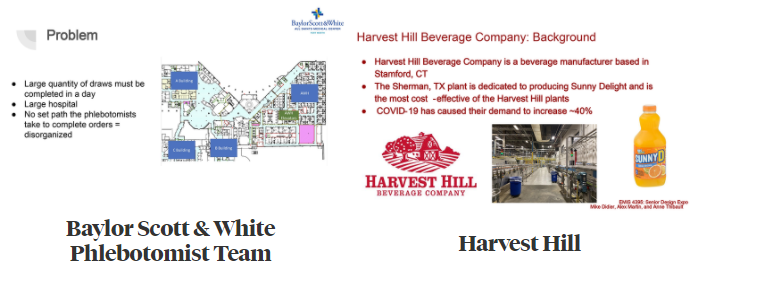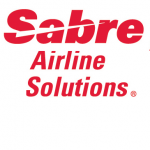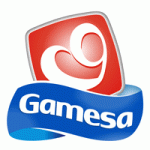Short summary videos and presentations of Lyle senior design projects for Spring 2021 are available here. Click on “EMIS” to see those by 13 Management Science teams.

Short summary videos and presentations of Lyle senior design projects for Spring 2021 are available here. Click on “EMIS” to see those by 13 Management Science teams.

Client: Los Barrios Unidos Community Clinic
Team: Shorjoe Bhattacharya and Harvey Hauw
Faculty Advisors: Drs. Barr, Bing Year: 2017
Documents: Presentation, Report
Los Barrios Unidos Community Clinic, located in West Dallas, offers services in many different healthcare areas including pediatric care, behavioral health, and obstetrics. The focus of this project was in the obstetrics department, at which patient satisfaction was dropping due to long wait times leading to long appointment durations.
Our team was tasked with collecting time and motion data, mapping out current workflows of the clinic, running a simulation model, and analyzing the results. We collected data with a simple yet effective time and motion study where we asked the individual patients to log their times as they went station to station in the clinic. We also learned the workflows and layout of the clinic by talking to staff members at the location. This was data was used in a computer simulation model of the Obstetrics wing, developed using “MedModel” (specialty healthcare facilities simulation software). The simulation results revealed ways to reduce patient wait times to improve the patient experience at LBUCC.
NBC Channel 5 news story: Southern Methodist University students focus their project on making the intersection of Fitzhugh and Travis streets in Dallas safer for pedestrians. Senior Design team Andrew Brunts, Hailey Phelps, and David Smith built a simulation of Fitzhugh Avenue traffic to evaluate configuration alternatives for a neighborhood improvement organization.
Client: ORM Technologies
Team: Lexi Farrar, Ashley Hall, Neimy Sarmiento
Faculty Advisor: Dr. Barr Year: 2014
Documents: Presentation, Report, Video
ORM Technologies currently has a call center client looking to make their call center more efficient. Currently, ORM Technologies has a functioning system that uses web-based inputs that allowing the customer to input data and generate optimized resource requirements. The system runs an Erlang C profile for every agent level in the pre-model. From there, the optimization selects the minimum headcount required by 30 minute intervals by day, week, month and year. Some models are 12 months, but most are 5 years.
Our team had the task of using Erlang B probability distribution to dynamically estimate and model the most cost-effective number of trunks, or phone channels, needed to service a live call center by trunk type. The optimization model is written in GAMS, General Algebraic Modeling System, for integration into the client’s existing system. (Our team has no prior experience with GAMS.)
Client: Sabre Airline Solutions
Team: Hunter Ross, Mary Liz Tuttle, Ramon Trespalacios
Faculty Advisor: Dr. Barr Year: 2014
Documents: Presentation, Report, Video
Sabre Airline Solutions offers data solutions and software to aid airlines sell products, market themselves, and operate efficiently. The company would like to provide traveler segmentation services for their customer reservation system to support various marketing programs. (Segmentation involves classifying prospective buyers into groups, or segments, to create products specifically for each segment.) This project required creating segmentation rules that classify ticket purchase data in this manner.
The senior design team replicated the data to create pre-booking and post-booking results. Pre-booking segmentation will show clusters that do not include variables such as fare and travel time, because these can’t be known until after booking. On the other hand, post‐booking data will provide segments that include purchases made. Pre-booking clusters could be used to make promotions for customers while booking, and post-booking clusters could be used to make promotions after booking.
The team used k-means clustering method and the R software to find the optimal number of clusters in the data and assist Sabre with the design of good fare products. For example, if an airline has created a ticket fare product for a specific market like business‐travelers, the team’s segmentation rules can confirm whether the product is well‐defined and well-targeted.
Client: Frito Lay
Team: Matt Alfano, Brittany Masi
Faculty Advisor: Dr. Barr Year: 2010
Documents: Presentation, Report, Video
The project is to design and create an out-of-stock inventory tool that is user-friendly and able to historically scan data while predicting inventory shortfall at the club/SKU level. More features of this project include determining what Inventory is needed by club/SKU and determine delivery frequency by club. We decided that only these opportunities fell into the scope of our project.
After consolidating all of the available information into one database we removed unnecessary tables to increase the processing speed of analyzing the product “Spy Reports” generated by their current database queries. We analyzed two of the highest-demand product lines that Frito Lay stocks at Sam’s Clubs nationwide. These two products are Smart Mix and Variety Mix. Continue reading
Client: Frito Lay
Team: Rodrigo Cantu, Sergio Hueck, Rafael Virzi
Faculty Advisor: Dr. Barr
Year: 2012
Documents: Presentation, Report, Video
Gamesa, a subsidiary of Frito-Lay, is a Mexican Cookie company that sells its product in many different countries, including the United States. Their products, which includes different types of cookies and crackers, are targeted to the Mexican population. The company’s United States sales force consists of 38 representatives in 16 different regions, organized by their different routes to market, location of warehouses, and population density. Today, they dominate the U.s. Hispanic cookie market occupying 50 percent of the market.
The problem we address for Gamesa is: should they should deploy more sales representatives and, if so, where would their optimal locations be? With the current economic recession and the entering of Gamesa’s main competitor, Bimbo, sales have been dropping in the different regions. This resulted in Gamesa asking themselves if they needed a bigger sales force. They also wanted to know what regions could be good to add representatives in the future depending on the migration of the population or the strategy of the competition. Continue reading
Client: Frito Lay
Team: Javier Gonzalez, Fernando Sada, Marcelo Sada
Faculty Advisor: Dr. Siems
Year: 2011
Documents: Final Report, Presentation
In order to satisfy the large Hispanic market in the United States, Frito Lay imports products manufactured in Mexico by Gamesa, a sister company to Frito Lay due to the fact that they are both owned by PepsiCo. Gamesa has plants all across Mexico, having the main ones located in Celaya, Vallejo, Obregon and Monterrey. In the past, all products being imported into the U.S were produced in Obregon, a city in Northwestern Mexico. As of today, the Hispanic population has dispersed all across the country, increasing Gamesa’s market to a large portion of it. Gamesa’s products are now being distributed all the way from California, to Texas, and onto the East Coast and Midwest. Imports have increased so much that in order to satisfy the demand, Gamesa has started producing all across Mexico for exports. Continue reading
The stories of three Senior Design projects from the clients’ point of view, including North Texas Food Bank, Texas Department of Transportation, and Southwest Airlines:
Client: Pratt & Whitney Engine Services
Team: Michael DeVore
Faculty advisor: Barr Year: 2004
Documents: Final report (Word)
The Pratt and Whitney Addison Service Center is a unique situation involving rental engines and their repair. These engines are delivered by a 3rd party carrier and must be checked over and repaired if necessary. At that point the engine must be sent back out to either the customer who rented it or to another intermediate step. The Addison, TX Service Center Manager requested help in optimizing the employee’s time spent on these rental engines. He wanted to know what could be done to improve Service Center response time and maximize output. Continue reading